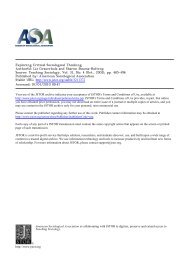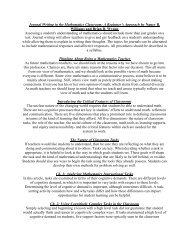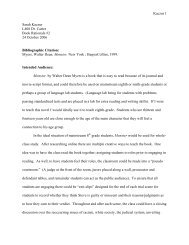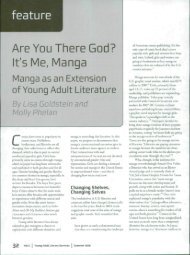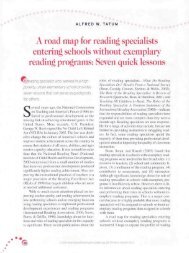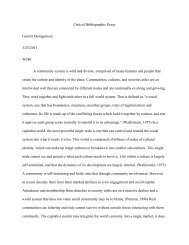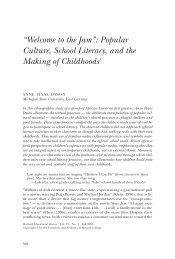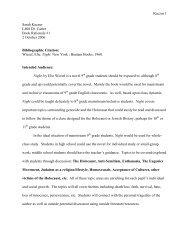Mills (2009) Interogating competing multiliteracy ... - Oncourse
Mills (2009) Interogating competing multiliteracy ... - Oncourse
Mills (2009) Interogating competing multiliteracy ... - Oncourse
Create successful ePaper yourself
Turn your PDF publications into a flip-book with our unique Google optimized e-Paper software.
106 K.A. <strong>Mills</strong><br />
Furthermore, this debate can be framed in the light of the diverse purposes of literacy<br />
in society today. Historically valued texts are not representative of the kaleidoscope<br />
of texts and literacies that children encounter in society. For example, the valued literature<br />
canon systematically excludes certain text types such as picture books, popular texts,<br />
romance and science fiction (<strong>Mills</strong> 2005a). Removing these popular fictions from the curriculum<br />
disenfranchises many groups and negates valuable opportunities to meet children’s<br />
interests. At the same time, ignoring the pervasiveness of popular culture leaves a significant<br />
number of gendered representations and stereotypes unopposed and unquestioned<br />
(Arthur 2001; Hollingdale 1995; Muspratt, Luke, and Freebody 1997; Singh 1997; West<br />
1992; Wyatt-Smith 2000). A pedagogy of multiliteracies provides opportunity for this critique.<br />
Furthermore, information texts, emails, websites, databases, visual literacies and oral<br />
discourses should not be overlooked as ‘inferior literacies’. In relation to the hierarchical<br />
ordering of textual practice, Luke (2000, 85) argues:<br />
...the‘new’electronicwriting is a different form of literacy – not an inferior or lesser form<br />
of some ‘golden age’ vision of literacy. The electronic typewriter was not a diminished form<br />
of literacy or handwriting . . .<br />
It is not argued here that there is no space for time-honoured, ‘quality’ literature in a<br />
pedagogy of multiliteracies. For example, some scholars have published work concerning<br />
both literature and multiliteracies, such as Unsworth (2006a, 2006b) and Mackey (1998),<br />
among others. These theorists have shown that the distinctions between ‘quality literature’<br />
and ‘popular culture’ is increasingly becoming blurred by a burgeoning variety of children’s<br />
literature and classic stories in electronic formats, published as CD-ROM versions and on the<br />
World Wide Web, supported by online communities, forums and chat rooms about literature<br />
(Unsworth et al. 2005). Whether ‘classical’ or ‘popular’, multimodal or monomodal, digital<br />
or not, the selection of texts for teaching multiliteracies needs to be done reflectively and<br />
critically. Failure to do so results in the reproduction of dominant cultural values, and<br />
compliance with the ‘literary tastes of the most powerful’ (Muspratt et al. 1997, 297).<br />
Multimodal design<br />
This section addresses the contention that the New London Group’s extension of linguistics<br />
(written and spoken words) to include multimodal texts is too broad to be useful to literacy<br />
curriculum and practice. Multimodality expresses the complexity and interrelationship<br />
of more than one mode of meaning, combining linguistic, visual, auditory, gestural or<br />
spatial modes. Visual meanings or modes include images, page layouts, screen formats,<br />
colours, perspectives, vectors, foregrounding and backgrounding. Audio meanings include<br />
music, voice-overs and sound effects. Gestural design involves body language, gestures,<br />
kinesics, feelings and behaviour. Spatial design includes environmental, architectural and<br />
geographical meanings (Kress 2000a; New London Group 2000).<br />
Multimodal design differs from independent modes because it interconnects the modes<br />
in dynamic relationships. It captures the multifaceted and holistic nature of human expression<br />
and perception, involving the whole body in the process of learning and semiosis<br />
(Kress 2000a, 2000b; New London Group 2000). It was members of the New London<br />
Group (2000, 19) who began to extend the linguistic semiotic system of Halliday (1978,<br />
1994) to incorporate visual, spatial, gestural and audio modes in a metalanguage of design<br />
(Cope 2000; Cope and Kalantzis 1999; Kress 2000a, 2000b; Kress and van Leeuwen 1996,<br />
2001). The New London Group (2000, 25–28) also uses the terms ‘meanings’, ‘modes of<br />
meaning’, ‘designs’ and ‘design elements’ as synonyms for ‘modes’.



